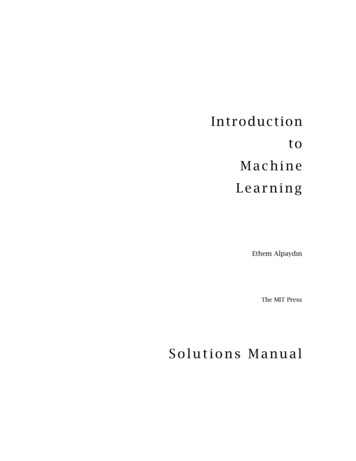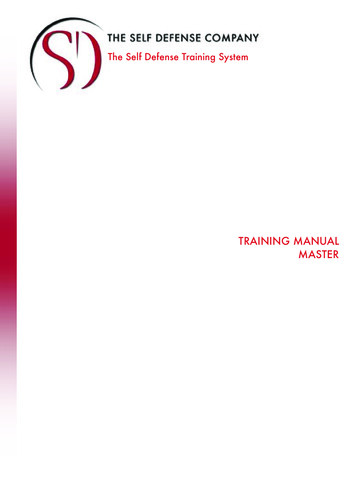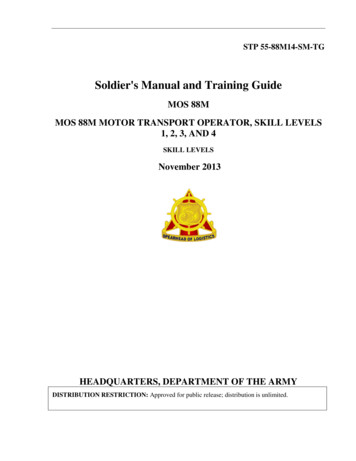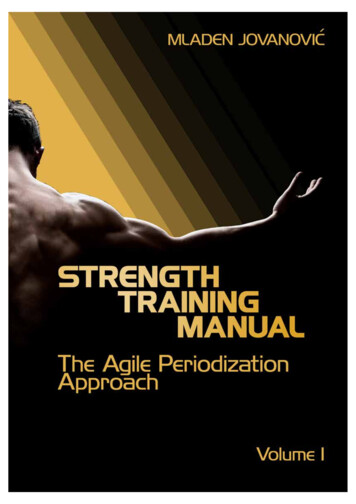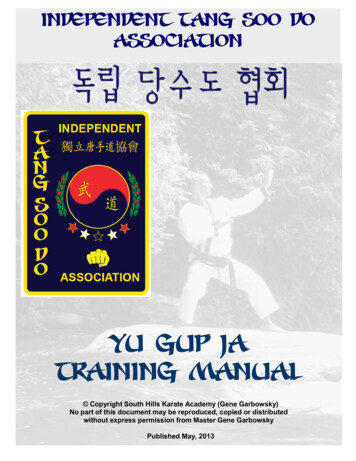
Transcription
Independent Tang Soo DoAssociationYU GUP JATRAINING MANUAL Copyright South Hills Karate Academy (Gene Garbowsky)No part of this document may be reproduced, copied or distributedwithout express permission from Master Gene GarbowskyPublished May, 2013
A Message from Sa Bom Nim Gene Garbowsky,Kwan Jang Nim, Independent Tang Soo Do AssociationAs a member of the Independent Tang Soo Do Association, I hope that you will come to realize the benefits of training in Tang Soo Do. As you may know, I have been teaching thisMartial Art to hundreds of students over the past 30 years. I truly believe that every man,women, and child can benefit in many ways from practicing Martial Arts and Tang Soo Do.What are Martial Arts? It is the name given to the traditional systems of self-defense thathave been practiced in Eastern and Western societies for thousands of years. Masters ofthe ancient Martial Arts ultimately discovered that mastery of the body comes through mastery of the mind. Therefore, the practice of Martial Arts is a way to a more fulfilling life. It is apath to freedom from self-confinement and the ultimate goal to mental and physical harmony.Martial Arts training can absolutely change aperson physically, psychologically, and emotionally in a very positive way. Regular physical activity energizes the body, and sincemartial arts are based on natural law, thebody can quickly reach top conditioning.Once physical changes develop, they soonlead to the mental and emotional improvements that many seek through the martialarts. Increased strength, loss of body fat, andimproved coordination can all lead to an improved self-image.However, progress can be a difficult journey.It requires hard work and determination.Through the martial arts, children and adultsSa Bom Nim Garbowskylearn how to handle hard work and how to go forward when one would rather give up. This is the greatest value of martial arts and it is ajourney and an education that can change your life and last a lifetime!Warm Regards,Master Gene Garbowsky6th Dan Tang Soo DoKwan Jang NimIndependent Tang Soo Do Assoc.2
Table of ContentsHistory of Tang Soo Do . 4About Kwan Jang Nim Garbowsky . 6The Independent Tang Soo Do Association . 9The Flag of The Independent Tang Soo Do Association . 10Association Student Guidelines .11Tang Soo Do Ten Articles of Faith .11The Purpose Of The Independent Tang Soo Do Association. 12The Association’s Responsibilities of Students . 12Responsibilities of Dan (Midnight Blue Belts) Members . 12The Rules of the Dojang . 13Class Time Rules . 14The Tang Soo Do Uniform . 15Practicing Outside of the Dojang . 15The Role of Flexibility . 16The Belt System of The Association . 17How To Tie The Belt or Dee (Korean) . 19Tang Soo Do Terminology and Culture . 20Traditional Hyung of Tang Soo Do . 28Independent Tang Soo Do Association Hyung Set . 30Bunhae Ki Sul . 34Kicho Hyung Ill Bu. 33Gup Combinations . 42Advanced Red Belt Combinations . 43Sam Gup Dae Ryun . 44Children’s Long Distance Sparring . 45Gup Testing Requirements. 463
History of Tang Soo DoTang Soo Do is a Korean martial art and thus can trace its lineageback almost 2,000 years. The ancestral Martial Arts of Korea canbe traced back to the period when Korea was divided into threekingdoms:Goguryeo was founded in 37 BC in northern Korea. The Silla Dynasty was founded in 57 BC in the southeast peninsula. The thirdkingdom, Paekche was founded in 18 BC.After a long series of wars, the Silla Dynasty united the three kingdoms in 668 AD. During this period, the primitive martial arts werevery popular as a method of self-defense in warfare. This is evident in the many mural paintings, ruins, and remains, which depict Tang Soo Do practice inthose days. Among the three kingdoms, the Silla Dynasty was most famous for its development of martial arts. A group of young aristocrats who were called "Hwa Rang Dan" wasthe major force behind the development of the art. These warriors were instrumental in unifying the Korean peninsula under the new Silla Dynasty (668 AD - 935 AD). Many of theearly leaders of that dynasty were originally members of the Hwa Rang Dan. Most Koreanmartial arts trace their spiritual and technical heritage to this group. In fact, the names ofsome martial arts such as Hwa Rang Do or Hwa Soo Do, still reflect this origination.The united Silla Kingdom was ultimately overthrown by a warlord, Wang Kun, in 918 AD.The new kingdom, "Koryo", lasted for 475 years (918 AD - 1392 AD). In 1392, the Yi Dynasty succeeded the Koryo kingdom. The Yi Dynasty remained intact for 500 years. Duringthe 1000 year period of the Koryo Kingdom and the Yi Dynasty, Tang Soo Do became verypopular within the military. The art also became very popular with the general public. During this period, Tang Soo Do was referred to as Kwon Bop, Tae Kyun, Soo Bahk, Tang Sooand others. The first complete Martial Arts book was written at this time. This most important book is called "Mooyae Dobo Tangji". It was written in 1790 and contained illustrationsthat substantiated the theory that Tang Soo Do (formally called "Soo Bahk Ki") had quicklydeveloped into a very sophisticated art of combat techniques.Tang Soo Do, as it exists today, is comprised of a combination of three major styles: YangTai Chi Chuan, Northern China and Southern China Kung Fu, combined with the Okinawan/Japanese discipline of Karate. In fact, Tang Soo Do is the Korean pronunciation of theHanja characters 唐手道 which is translated as “Way of the T’ang (China) Hand. In Japanese these characters mean Karate-do. Currently, Japanese Karate-do is written as 空手道The Japanese pronunciation of both sets of characters is the same, but the newer versionmeans "Way of the Empty Hand" rather than "Way of the T'ang Hand".4
Virtually every Tang Soo Do School either affiliated with a large organization such as SouthHills Karate Academy can trace it’s lineage back to the Moo Duk Kwan1 (Institute of MartialVirtue). The Moo Duk Kwan, one of five original schools or “Kwans”, was founded around1945 by Grandmaster Hwang Kee and it’s history is very unique. The original Kwans andtheir founders were the Chung Do Kwan (LEE, Won Kuk), Jidokwan (CHUN, Sang Sup),Chang Moo Kwan (YOON, Byung In), Moo Duk Kwan (Hwang Kee), and Song Moo Kwan(ROH, Byung Jick). Most of these schools called the Martial Art they were teaching TangSoo Do or Kong Soo Do. Around 1953, shortly after the Korean War, four more annexKwans formed. These 2nd generation Kwans and their principle founders were; Oh DoKwan (CHOI, Hong Hi & NAM, Tae Hi), Han Moo Kwan (LEE, Kyo Yoon), Kang Duk Kwan(PARK, Chul Hee & Hong Jong Pyo) and Jung Do Kwan (LEE, Young Woo).In 1955, these Kwans were ordered to unify by South Korea's President Syngman Rhee. Agovernmental body selected a naming committee's submission of "Taekwondo" as thename. In 1959, the Korean Taekwondo Association (KTA) was formed in an attempt tounify the dozens of the kwans as one standardized system of Taekwondo. The first international tour of Taekwondo, by General CHOI, Hong Hi, and NAM, Tae Hi founder of the OhDo Kwan (founded 1953-54), and 19 black belts, was held in 1959. Despite this unificationeffort, the kwans continued to teach their individual styles. The Korean government ordered a single organization be created, and on September 16, 1961, the kwans agreed tounify under the name Korea Tae Soo Do Association (which changed its name back to theKorean Taekwondo Association when Choi became its president in August 1965). Historytells us that the Moo Duk Kwan pulled out of the unification efforts to remain independentand to distance itself from the sporting aspects of Taekwando.In 1995 the Moo Duk Kwan changed the name of the system taught in their organization toSoo Bahk Do, no longer using the name of Tang Soo Do. Whereas Tang Soo Do has beenassociated with the Moo Duk Kwan since 1945, schools who are not chartered members ofthe Moo Duk Kwan are no longer permitted to refer to the style of Martial Art as Tang SooDo Moo Duk Kwan. This has not stopped the development of Tang Soo Do. Tang Soo Docontinues to evolve and grow, and in the last two decades has emerged as one of the mostpopular Martial Arts in the world today. True martial arts lovers desired to continue the pursuit of traditional martial arts because Taekwondo had to abandon many valuable aspectsof true martial arts to become a competitive sport. Tang Soo Do practitioners strive tomaintain traditional values of respect, discipline, self-control, self-improvement, etiquette,and ultimately live a healthy and harmonious life, physically and mentally.The Association can trace its lineage back to the original Moo Duk Kwan through its instructor Master Gene Garbowsky (ITF#26272), back through his two previous instructors, KwanJang Andrew Ah Po (#10187), founder of The Tang Soo Do Martial Way Association, as wellas Master Garbowsky’s original instructor, Kwan Jang Nim Chun Sik Kim (#915), founder ofthe International Tang Soo Do Federation1.5
The Independent Tang Soo Do Association offers instruction in other disciplines as well.These include, grappling arts, kick boxing, boxing, and others. The primary focus includes: Traditional Tang Soo Do (Karate) TechniquesSelf-defense (Ho Sin Sool)Traditional Tang Soo Do Forms (Hyung)Bunhae Ki Sul (Application of Hyung Techniques)Traditional Sparring Techniques (Dae Ryun)Weapons TrainingBoxing TechniquesKick Boxing SkillsStrength Training ExercisesMeditation and other advanced relaxation techniquesAbout Kwan Jang Nim Gene GarbowskyMaster Gene Garbowsky began his martial art career in the early 1980s by training in thetechniques and traditions of Korean Tang Soo Do. During the 1990s while attending PennState University, he also addedto his martial arts resume bytraining in Tae Kwon Do, Judo,Japanese Shotokan Karate,Kick Boxing and Boxing. Master Garbowsky has owned andoperated professional martialarts studios at Penn State University (State College), PA,North Huntingdon, PA and Pittsburgh, PA. He has trained literally thousands of students inTang Soo Do from ages 4 toover 70 years of age! Many ofhis students have gone on to betop karate competitors acrossthe United States.Since this time Master Garbowsky has had an opportunity Kwan Jang Nim Ah Po awards Master Garbowsky O-Dan rank(October,2008)to train, practice and attendseminars with some of the mostnotable Tang Soo Do Grandmaster and Master in the United States today.1. *note: South Hills Karate Academy is not affiliated in any way with the Moo Duk Kwan. The information is provided as an historical account of Tang SooDo. Despite prior association, South Hills Karate Academy is in no way associated with the International Tang Soo Do Association, Grandmaster Chun SikKim or the Tang Soo Do Martial Way Association and Grandmaster Andy Ah Po.6
In October of 2007, South Hills Karate Academyheld its 1st Dan Testing Championship of TangSoo Do. World renowned Tang Soo Do Grandmaster Andy Ah Po founder of the Tang Soo Do MartialWay Association, at the request of Master Garbowsky, conducted this historic event. At this event,which was deemed the "2007 Tang Soo Do FallWeekend in Pittsburgh", Grandmaster Ah Po conducted three special clinics for Tang Soo Do Ko DanJa and Yu Dan Ja in the Pittsburgh area. It was afterthis visit that Master Garbowsky was accepted byGrandmaster Ah Po as a direct student and Ko DanJa member in the Tang Soo Do Martial Way Association.In October, 2008 Master Garbowsky was awardedMaster Garbowsky (right) and Master5th Dan (Oh Dan) by Grandmaster Andy Ah Po atKevin Watson, 7th Dan Shito-Ryu Karatethe 2nd Annual Fall Weekend in PittsburghDo Demonstrate Sam Soo Shik DehRyunevent. This was after an extensive evaluation andtesting procedure that involved four days of intensive evaluation by Kwan Jang Nim Ah Po during Master Garbowsky’s trip to Sacramento inJanuary of 2008.In January 2012 at the urging of various otherheads of Tang Soo Do organizations in the UnitedStates Master Garbowsky founded the Independent Tang Soo Do Association. His primary goalsare to bring together various Tang Soo Do organizations and to provide his students with an internationally recognized organization that helps tofoster the original teachings of the late GreatGrandmaster Hwang Kee. This is accomplishedby tapping into the instruction and teaching he reMaster Garbowsky (center) Demonstratesceived from his two instructors and fostering theE-Dahn Ka Whe Cha Gi “Flying ScissorTang Soo Do concept of Ryu Pa.Kick”Master Garbowsky holds a Bachelor of Science Degree from the Pennsylvania State University (1992).7
Summary of Master Garbowsky’s Achievements 1986 Began teaching Tang Soo Do in Pittsburgh at the age of 16 years old1988 Awarded first Dan (Black Belt) (Dan# 26272) by International Tang Soo Do Federation1991 Head Tang Soo Do Instructor and co-owner, State College Martial Arts Academy, State College, PA1991 Penn State Judo1992 USA Karate Team Member1993 Head Instructor, Pittsburgh and owner of CS Kim Karate, Irwin, PA1994 ITF “Forms Competition”, World Championship Runner-Up1994, 1995, 1996, 1997 Outstanding Demonstration Awards1995 Maryland State Invitational Karate Championships “Grand Champion”, EagleClassic2000 Awarded Masters Degree by the International Tang Soo Do Federation2005 Opened South Hills Karate Academy at 4500 Clairton Blvd. Pittsburgh, PA 152362006 NAKF Tournament Forms “Grand Champion”2008 Awarded 5th Dan Master Rank by the Tang Soo Do Martial Way Association2005-2009 expanded South Hills Karate Academy to over 160 full-time students2009 Opened 2nd location for South Hills Karate Academy in Elizabeth, PA2009 Trained and promoted 12 students to Cho-Dan ranking and 2 to Ee-Dan rankingin the Tang Soo Do Martial Way Association2011 Opened new location for South Hills Karate Academy and the new MartialFitTraining center providing students of the art of Tang Soo Do both top quality instructionin Tang Soo Do and well as strength and fitness training2011 Promoted 4 students to the Cho-Dan rank2011 Franchised South Hills Karate Academy, Elizabeth location2012 Founded the Independent Tang Soo Do AssociationSouth Hills Karate Academy’s 2ndDan Classing ExaminationBack Row: Masters, C. Terrigno, A.Preston, S. Preston, J. Dove, G. Petroski, Kwan Jang Nim Ah Po, S. Propst,J. Ennis, K. Watson, G. Garbowsky 2ndRow: J. Weir, R. Diffendal, K. Garbowsky, B. Maxwell, C. Durney, D. Wilson, C. Wilson, D. Hafer Kneeling: C.Durney, E. Garbowsky, D. Pruni, C.Vickless, E. Irson, D. Pruni8
The Independent Tang Soo Do AssociationIn January 2012, Sa Bom Nim Garbowsky (Dan#26272) founded The Independent Tang Soo Do Association.The primary objectives of the Association are to preserve and promote the original and traditional techniques, practices, philosophy, and principles of themartial art known as Tang Soo Do, and to create atraining environment that not only focuses on intensephysical training, discipline, and respect (Moo Do),but which also fosters creativity and character development (Ryu Pa) by recognizing the human need toachieve "freedom" through the development of thehuman spirit (Moo Do Shim Gung).As a martial artist you will receive a number of benefits as a member of the Association. The Associationwill provide the foundation for its members to gain anin-depth understanding into Tang Soo Do philosophy, fostering a well-rounded, quality-based programinclusive of the many aspects of Tang Soo Do. In addition, it will encourage growth of the spirit of martial arts within each of its members. However, it serves to achieve this by adding to member schools’ already established curriculum and not forcing a particular Tang Soo Do curriculum upon Association members asthis would be in violation of the late Great Grandmaster Hwang Kee’s spirit of Ryu Pa.However, it is expected that Association members maintain the highest level of proficiency.This is achieved by providing learning and sharing opportunitiesthrough seminars and clinics, Tang Soo Do competitions, and Gup andDan Shim Sa among Association studio members and their instructorsand students. A higher level of proficiency in Tang Soo Do can beachieved through technical instruction and guidelines for each memberschool.The Association will remain a member-friendly organization and willstrive to provide the highest quality services to its members includingtraining opportunities, consultation and valuable products. Additionally,studio members have access to Gup and Dan certificates, testing materials, and manuals that will add to the studio owners Association experience.9
Flag of The Independent Tang Soo Do AssociationThe Kwan Gi represents the Independent Tang SooDo Association’s rich martial arts heritage. The background being midnight blue represents the Koreanculture and origin of Tang Soo Do. In traditional TangSoo Do, midnight blue represents the Yu Dan Ja(black belt) ranking instead of the known ‘black belt’that is used in other martial arts systems. Additionallyin Korean culture this color signifies maturity and success. Therefore the background color is a representation of our Yu Dan Ja members and their success andunity in the art of Tang Soo Do.獨立唐手道協會 is the hanja or Chinese charactersfor Independent Tang Soo Do Association. This is adirect translation from English. Independent Tang SooDo Association can also be written as 中立唐手道協會 meaning to be separate from others or standingalone or apart.The red, white, and blue stars represent the United States of America. Sa Bom NimGarbowsky felt it important to have the United States represented in the Kwan Gi as somany Tang Soo Do schools and organizations have found success here in America teaching Tang Soo Do. Additionally if you study the history of Tang Soo Do, you will find that itreally spread from the US service men who were stationed in Korea during the mid to late1950s who when they returned to the US started teaching and spreading Tang Soo Do.The gold throughout the flag represents justice as does the gold fist. In addition, thegold fist represents our tie to the original Moo Duk Kwan founded by Grandmaster HwangKee. The berries on the laurel leaves represent the fruit we obtain through training.There are eight on each side also representing the eight key concepts of Tang Soo Do.The laurel leaves themselves represent life and our growth in Tang Soo Do and as an individual.The um/yang symbol represents the Tao (Do) and the dualities of nature and life. On eachside of the symbol you find the Chinese characters for “Moo and Do” or Martial Way.These characters together represent the concept of conflict resolution both internally andexternally.All South Hills Karate Academy members are to wear the Association patch on the rightsleeve, just below the hem on the dobalk.10
Association Student GuidelinesAs with the tradition first set by the Moo Duk Kwan in 1945, every student must displayproper respect and discipline. Each student must also adhere to the three principles of theIndependent Tang Soo Do Association:The Association’s Core Principles RespectDisciplineStrengthRespect refers to the respect that is developedand fostered through the training of Tang SooDo. It is the respect that every member atSouth Hills Karate Academy has for others aswell as themselves. Discipline is necessary forsuccess in Tang Soo Do and life. Without discipline one can easily lose control of themselves and their life. Strength refers to both physical and mental strength.Membership in the Association comes with serious responsibility and that is to represent theArt and the School in only the best possible manner. Students who fail in this regard will beasked to revoke their membership. Remember that Tang Soo Do is a classical martial artand not a sport. It is an intellectual activity designed to foster physical, mental, and spiritualhealth.Students must strive to separate themselves from average people by developing strongmoral character, humility, and respect for others. The Ten Articles of Faith must be practiced and followed and each student must realize that they are living examples of Tang SooDo and the brotherhood that exists between all martial art styles.Tang Soo Do Ten Articles of Faith1.2.3.4.5.6.7.8.9.10.Be loyal to your country.Be obedient to your parents.Be loving between husband and wife.Be cooperative between brothers.Be faithful between friends.Be respectful to your elders.Be faithful between teacher and student.Know the difference between good and evil.Never retreat in battle.Always finish what you start.11
The Purpose Of The Independent Tang Soo Do AssociationThe purpose of the association is to promote the original and traditional techniques, practices, philosophy,and principles of the martial art known as Tang Soo Doand to create a training environment that not only focuses on intense physical training, discipline,and respect (Moo Do), but which also fosters creativityand character development (Ryu Pa). This is accomplished by recognizing the human need to achieve"freedom" through the development of the humanspirit (Moo Do Shim Gung).The Association’s Responsibilities of Students1.2.3.4.5.Look and listen to learn.Practice until you are both physically and mentally challenged.Make positive changes by taking yourself outside of your comfort zone.Develop a higher level of conscious awareness.Create Ryu Pa.The Independent Tang Soo Do Association’s Responsibilities ofDan (Midnight Blue Belts) Members Maintain Tang Soo Do protocol and etiquette. Tang Soo Do protocol and etiquette has a long tradition starting with those of the Moo Duk Kwan. Failure to adhere to these wouldresult in a degradation of the art. It is also the Dan’s responsibility to pass these on tojunior ranks.Remember that you are always a student. Continue to develop skills needed to become afuture leader in the dojang and the Association to further promote, perpetuate, and enhance the martial art of Tang Soo Do.Conduct yourself in a manner that is worthy of being Dan member and remember thatjunior students and others are always watching you and hold you in high regard and to ahigher standard.Always continue your training and study the history and traditions of Tang Soo Do andparticipate in as many dojang and Association events as possible.Remain loyal to your instructor and the Association as this is the highest level of Moo DoShim Gong (Spirit of the Martial Arts) . This also ensures the purity of the martial art aswell as our identity as an Association.12
The Rules of the DojangMartial arts training begins with learning how to respect the tradition of the art andthe school. With membership in any organization there are rules that must be followed andadhered to. The following “Rules of the Dojang” must be followed without question.Entering the DojangStudents should salute the flags and bow to the senior Black Belts and the Master Instructorimmediately upon entering the Dojang (training room). This should be done without exception. Students do not have to wait for Black Belts or the Master Instructor to acknowledgetheir bows. At first students feel awkward using the bow. This is understandable but oncestudents realize that the bow acknowledges respect, a respect between people that is muchdeeper than any handshake or other form of acknowledgment, it will become second nature.Starting the ClassThe instructor will stand at the front of the class. All others students will line up behind theinstructor according to rank and seniority right to left. Lines will be evenly numbered andform with seniors to the right. Note:After class has been lined up properly, the instructor or highest ranking member will startclass by calling the following commands:Cha RyutKuk Gi Ba RaeBa RoAhn JoMuk NyumBa RoAttentionSalute to the FlagsReturnSitMeditation and mind preparationReturnThe highest ranking member in class will then call the class to attention and bow to the instructor. The following Korean commands are used:Kwan Jang Nim Ke Kyung YetSa Bom Nim Ke Kyun YetKyo Sa Nim Ke Kyung YetYu Dan Ja Ke Kyung YetYu Gup Ja Ke Kyung YetBow to Grand MasterBow to the Master InstructorBow to the InstructorBow to Dan(s), Bow to Dan InstructorBow to Gup Instructor13
Class Time RulesDuring class, proper respect and discipline must be maintained at all times.1. If a student comes to class late, he or she will wait at the Dojang entrance until the instructor acknowledges them. They will then approach the instructor, bow, and ask for permission to join class.Note:Students should make every attempt possible to arrive early for class.This way proper respect will be paid to the instructor and there will besufficient time for warm-up exercises.2. Under no circumstance is a student to leave class without permission. To do so willshow disrespect to the instructor and the other students. Students must gain the permissionof the instructor in order to leave class for any reason. To return, students must stand at attention at the entrance of the Dojang, until welcomed back in by the instructor.3. Questions to the instructor or senior members should be preceded by a bow. If a studentis seated, he or she should raise their hand, and wait to be acknowledged by the instructor.4. A chain of command should be followed for questions outside of class. If a senior Gup isunable to answer a question, a Dan member should be approached. The Master Instructorshould be approached only as a last resort.5. Members should keep a posture that is conducive to good health, while they are seatedon the floor. This means sitting with the legs crossed, back straight, and hands on theknees. Seated members should also pay the utmost attention to seniors who are performing. A lot can be learned by watching those who are more advanced. Talking while seated isnot allowed.6. Students should never ask their instructor to teach them something new. This is disrespectful. Place trust in your instructor's knowledge and experience.7. Master Garbowsky should always be addressed as Kwan Jang Nim. Black Belt (Dan)Members should be addressed as either "sir" or "ma'am". It is also accept able to addressDan Members with Mr., Miss, Ms., or Mrs. followed by their last name. Studio instructorsshould be called either "Sa Bom Nim" (Master Instructor) or "Kyo Sa Nim" (Instructor UnderMaster).8. The instructor may, upon discretion, ask students who do not obey the above class guidelines to remove themselves from class.14
The Tang Soo Do UniformHow to Fold the Do BalkIt is important to give a good impression of our art. Therefore a neatappearance is essential at all times. Members should take care toclean their uniforms and keep them well-pressed. They should alsonot wear them in public, except for special events. Clothing shouldnot be worn underneath the dobalk either, except in the case of females, who are allowed to wear a t-shirt. The belt should be tiedaround the waist with rank displayed outward, from the left side.Why do we wear the traditional Tang Soo Do dobalk? The answerto this question is based on tradition and philosophy. First, the word"do" means "way of life" and the word "balk" means "clothing". Bydefinition, this makes the dobalk clothing for Tang Soo Do training.Its whiteness symbolizes purity and reverence for life . The belt is asymbol of our accomplishments in Tang Soo Do, both physicallyand spiritually. The uniform should always be kept in good condition, with proper patches and trim displayed. The belt should neverbe placed on the ground. The Independent Tang Soo Do Association Patch is displayed on the right sleeve. Individual school patches should be displayed on the leftside of the dobalk over the heart.Practicing Outside of the DojangStudents learn basic moves in class. These moves ortechniques should be practiced diligently until they areperfected including practice outside of the dojang. Students should take what they learn in class and work toperfect their techniques. Students should practice outside of the dojang in order to assure that they havelearned the techniques fully. Practicing outside of thedojang should include the practice of basic techniques,hyung, one-step sparring and if a training partner isavailable, free-sparring.In addition to practicing the techniques of Tang Soo Do, students are reminded to work on flexibility and strength training in order to improve the overall health of the body and tohelp improve performance in Tang Soo Do.Students are also encouraged to learn about the history anddifferent training philosophies of Tang Soo Do.15Master Garbowsky with GrandmasterD.A. Giacobbi
Th
the ancient Martial Arts ultimately discovered that mastery of the body comes through mas-tery of the mind. Therefore, the practice of Martial Arts is a way to a more fulfilling life. It is a path to freedom from self-confinement and the ultimate goal to mental and physical har-mony. Martial
